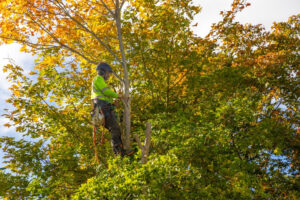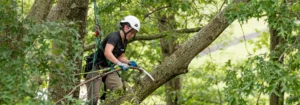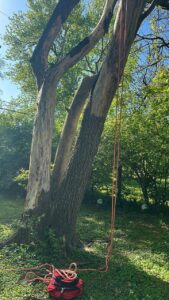Preserving Trees in Richmond, VA: A Vital Imperative
In the heart of Virginia lies Richmond, a city adorned with a tapestry of trees that not only embellish its landscape but also serve as guardians of its well-being. In this article, we delve into the significance of preserving trees in Richmond, VA, exploring the myriad benefits they bestow upon the environment, economy, and society.
Why Trees are Important
- Environmental Benefits: Trees stand as silent sentinels, steadfastly combating the onslaught of environmental degradation. Through photosynthesis, they absorb carbon dioxide, purifying the air we breathe and mitigating the adverse effects of climate change. Additionally, their sprawling roots anchor soil, preventing erosion and safeguarding waterways from pollution.
- Economic Benefits: Beyond their ecological prowess, trees wield considerable economic clout. Research indicates that strategically planted trees can reduce energy costs by providing shade and windbreaks, thereby lowering the demand for heating and cooling. Moreover, neighborhoods adorned with lush canopies often witness a surge in property values, bolstering real estate markets and fostering economic prosperity.
- Social and Health Benefits: In the bustling urban landscape of Richmond, trees serve as verdant sanctuaries, offering respite from the frenetic pace of city life. Studies have shown that exposure to green spaces can alleviate stress, boost mood, and enhance overall well-being. Furthermore, trees act as natural noise barriers, muffling the cacophony of urban clamor and fostering tranquil environments conducive to mental rejuvenation.
Threats to Trees in Richmond, VA
Despite their indomitable stature, trees in Richmond face an array of formidable adversaries.
- Urban Development: As urbanization encroaches upon natural habitats, vast swathes of woodland succumb to the relentless march of concrete jungles. The relentless expansion of infrastructure and residential areas threatens to displace native flora, fragment habitats, and diminish biodiversity.
- Climate Change: The specter of climate change looms ominously over Richmond’s arboreal landscape. Rising temperatures, erratic weather patterns, and prolonged droughts conspire to weaken trees, rendering them susceptible to disease, pest infestations, and premature mortality. Furthermore, shifting climatic conditions disrupt the delicate balance of ecosystems, imperiling the survival of countless species reliant on trees for sustenance and shelter.
- Invasive Species: The proliferation of invasive species poses a dire threat to Richmond’s native flora. Non-native plants such as the Tree of Heaven and the Bradford Pear outcompete indigenous species for resources, destabilizing ecosystems and undermining biodiversity. Moreover, invasive pests like the Emerald Ash Borer ravage tree populations, leaving devastation in their wake.
- Diseases and Pests: The incursion of pathogens and pests poses a grave peril to Richmond’s trees. Diseases such as Dutch Elm Disease and Oak Wilt inflict widespread devastation, decimating entire species and leaving barren landscapes in their wake. Concurrently, invasive pests such as the Gypsy Moth and the Hemlock Woolly Adelgid wreak havoc on vulnerable tree populations, precipitating ecological imbalance and habitat degradation.
Importance of Preserving Trees
- Mitigating Climate Change: In an era plagued by climate upheaval, the preservation of trees emerges as an indispensable tool in the fight against environmental degradation. By sequestering carbon dioxide and releasing oxygen, trees act as stalwart guardians of the atmosphere, tempering the ravages of climate change and ensuring a sustainable future for generations to come.
- Improving Air and Water Quality: Trees serve as nature’s air purifiers, filtering out pollutants and particulate matter from the atmosphere. Through a process known as transpiration, they release moisture into the air, fostering cooler microclimates and mitigating the urban heat island effect. Moreover, their intricate root systems act as natural sponges, absorbing excess rainfall and preventing runoff, thus safeguarding water quality and mitigating the risk of flooding.
- Supporting Biodiversity: Richmond’s diverse array of trees sustains a rich tapestry of life, providing habitat and sustenance for an array of flora and fauna. From towering hardwoods to delicate understory plants, each species plays a vital role in maintaining the intricate web of life that thrives within the city’s verdant corridors. By preserving trees, we safeguard the biodiversity upon which our ecosystems depend, ensuring the continued existence of myriad species for generations to come.
- Enhancing Property Values: The presence of trees confers tangible benefits upon property owners, enhancing the aesthetic appeal and marketability of real estate. Studies have shown that homes nestled amidst mature trees command higher prices and spend less time on the market than their treeless counterparts. Moreover, the shade and privacy afforded by trees augment the livability of residential neighborhoods, fostering a sense of community and belonging among residents.
- Promoting Mental and Physical Well-being: Amidst the hustle and bustle of urban life, trees offer solace to weary souls, beckoning with their tranquil beauty and verdant embrace. Access to green spaces has been linked to myriad health benefits, including reduced stress, improved mood, and enhanced cognitive function. By preserving trees, we cultivate environments conducive to physical activity, social interaction, and mental rejuvenation, fostering healthier and happier communities.
Conservation Efforts in Richmond, VA
Despite the myriad challenges facing Richmond’s trees, concerted conservation efforts offer a glimmer of hope for their preservation.
- Tree Planting and Maintenance Programs: Local governments and environmental organizations in Richmond VA have implemented robust tree planting and maintenance programs aimed at bolstering tree cover and enhancing urban green spaces. Through initiatives such as tree giveaways, community tree plantings, and arborist-led workshops, residents are empowered to take an active role in safeguarding their arboreal heritage.
- Preservation of Natural Areas: Efforts to preserve natural areas and green corridors play a pivotal role in safeguarding Richmond’s biodiversity and ecological integrity. Organizations such as the James River Park System and the Virginia Department of Conservation and Recreation work tirelessly to acquire and protect critical habitat, ensuring the continued existence of native flora and fauna for future generations to enjoy.
- Community Involvement and Education: Engaging communities in tree conservation efforts is paramount to ensuring their success and longevity. Through outreach programs, educational workshops, and volunteer opportunities, residents are equipped with the knowledge and resources needed to become stewards of their local environment. By fostering a sense of ownership and pride in Richmond’s trees, we cultivate a culture of conservation that reverberates throughout the community.
Conclusion
In the verdant tapestry of Richmond, trees stand as silent sentinels of resilience and vitality, beckoning us to cherish and protect them for generations to come. As stewards of our shared planet, it is incumbent upon us to heed their call, for in their preservation lies the promise of a greener, healthier, and more vibrant future for all. Let us stand together in defense of Richmond’s trees, for they are not mere denizens of the landscape but guardians of our collective well-being. The time to act is now.



